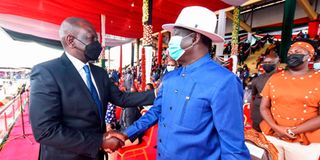In Ruto, Raila’s political merry-go-round finally meets its Waterloo

Deputy President William Ruto (left) with ODM leader Raila Odinga during Mashujaa Day celebrations at Wang’uru Stadium in Kirinyaga County on October 20, 2021.
What you need to know:
- Ruto has out-run, out-foxed, out-messaged and out-debated the Azimio flagbearer.
- In Dr Ruto, he has met a presidential candidate he cannot match and the end of his political merry-go-round is nigh.
For 20 years, Mr Raila Odinga has run roughshod over Kenya’s political scene.
In that period, he has been a Cabinet minister, led a campaign to derail a referendum on a proposed constitution in 2005, become a prime minister and returned to opposition benches outside Parliament.
For 25 years, Mr Odinga has mostly been in the opposition and after losing elections – 1997, 2007, and 2017 – he has literally wormed himself into the respective governments following the political rapprochement with Kenya’s three presidents.
The deals have benefited Mr Odinga in no small measure.
Unfamiliar waters
But in the lead-up to the elections in a week’s time, the ball game has been different and Mr Odinga has found himself in unfamiliar waters.
Deputy President and United Democratic Alliance (UDA)/Kenya Kwanza presidential candidate William Ruto has out-run, out-foxed, out-messaged and out-debated the Azimio flagbearer.
This is the first time in many years that Mr Odinga has literally fled from a political contest.
For this is what the presidential debate is and was about: A contest of ideas, a contest of policies.
His excuses for evading a face-off with Dr Ruto were not only laughable but also unintelligent.
Yet sources had intimated as early as May that his campaign team was not ready to have him debate the DP.
They saw the contest as a slaughterhouse for their candidate.
This was a clear testimony that he knew Dr Ruto was going to make mincemeat of him.
He also understands that he has an inferior programme for Kenya and he did not want voters to watch the distinction live on prime-time television, radio and online pages.
The DP was spot on when said during the debate: “My competitor is not here because he has no plan.”
Dr Ruto has run a campaign on one critical issue Mr Odinga’s has developed goose pimples over – the bottom-up economy and how it will lift tens of millions of Hustlers at the bottom of the pyramid.
The Azimio candidate started his campaign by cruelly dismissing the vulnerable and disadvantaged people – mama mboga, boda boda riders and mkokoteni pushers, among others – as trash.
Soon, he realised he had lost the way and has been trying to play catch-up ever since, but with disastrous results.
Campaigner-in-chief
In years past, Mr Odinga has been the quintessential campaigner-in-chief.
He out-campaigned President Mwai Kibaki in 2007 and could have done the same to President Uhuru Kenyatta in 2013 and 2017 save for Dr Ruto.
But in the past two years, the Azimio presidential candidate has not been able to match the DP.
For Mr Odinga, this is an election where he has been lagging behind on all fronts. August 9 will not be any different.
In Dr Ruto, he has met a presidential candidate he cannot match and the end of his political merry-go-round is nigh.
Mr Odinga’s political merry-go-round has been long and duplicitous.
In early 1998, he joined then leading opposition candidate, Mr Kibaki, to reject the December 1997 presidential election, which President Daniel Moi had won.
But a few days later, he congratulated the winner and an arrangement called ‘cooperation’ between their two political parties ensued.
This partnership was evident in Parliament where Mr Odinga’s National Development Party (NDP) worked with Kanu in a near-hung House where the ruling party only had a majority of four.
Benefited immensely
And Mr Odinga benefited immensely. In 2001, the NDP group was formally accommodated in President Moi’s government.
Mr Odinga was appointed Energy minister, while Dr Adhu Awiti, a member of his party, became the Minister for Planning. Another two NDP members were picked as assistant ministers.
During this season, Mr Odinga was able to get possession of the Kisumu Molasses Plant, a state corporation that had had a long history with not-so-rosy a story.
The cooperation between his party and Kanu smoothed the way for the factory take-over.
In March 2002, nine months before the general election, Mr Odinga’s NDP was dissolved and he became secretary-general of the ruling party.
But six months later, the whole edifice came crumbling down with Moi’s preference for Mr Uhuru Kenyatta as his successor.
It was time for Mr Odinga to go feast on new pastures. NDP and the disgruntled Kanu group joined Mr Kibaki to form the political juggernaut that became the National Rainbow Coalition (Narc).
In 60 days, they won the election and Mr Odinga was appointed a Cabinet minister on January 3, 2003. The following day, the war in Narc started.
The Odinga group rebelled against President Kibaki. The contest between President Kibaki and Mr Odinga in the 2007 election ended in devastating post-election violence, with more than 1,000 dead and 600,000 displaced.
Mr Odinga became Prime Minister in the negotiations that followed.
Now, Mr Odinga has been in government since his handshake with President Kenyatta in 2018. The merry-go-round has reached its sell-by-date.
Mr Buku works in the William Ruto presidential campaign; [email protected]





